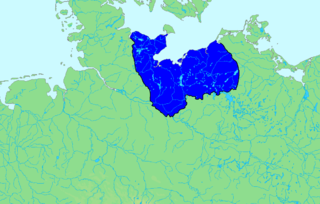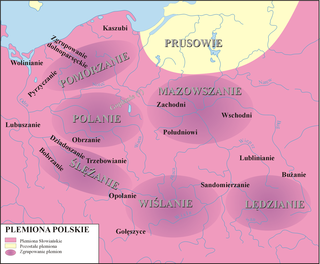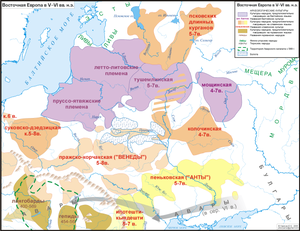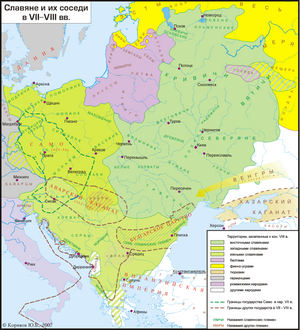
Slavs are the largest European ethnolinguistic group. They speak the various Slavic languages, belonging to the larger Balto-Slavic branch of the Indo-European languages. Slavs are geographically distributed throughout northern Eurasia, mainly inhabiting Central and Eastern Europe, and the Balkans ; and Siberia to the east. A large Slavic minority is also scattered across the Baltic states and Central Asia, while a substantial Slavic diaspora is found throughout the Americas, as a result of immigration.

Wends is a historical name for Slavs living near Germanic settlement areas. It refers not to a homogeneous people, but to various peoples, tribes or groups depending on where and when it was used. In the modern day, communities identifying as Wendish exist in Slovenia, Austria, Lusatia, Texas, and Australia.

The Obotrites or Obodrites, also spelled Abodrites, were a confederation of medieval West Slavic tribes within the territory of modern Mecklenburg and Holstein in northern Germany. For decades, they were allies of Charlemagne in his wars against the Germanic Saxons and the Slavic Veleti. The Obotrites under Prince Thrasco defeated the Saxons in the Battle of Bornhöved (798). The still heathen Saxons were dispersed by the emperor, and the part of their former land in Holstein north of Elbe was awarded to the Obotrites in 804, as a reward for their victory. This however was soon reverted through an invasion of the Danes. The Obotrite regnal style was abolished in 1167, when Pribislav was restored to power by Duke Henry the Lion, as Prince of Mecklenburg, thereby founding the German House of Mecklenburg.

The East Slavs are the most populous subgroup of the Slavs. They speak the East Slavic languages, and formed the majority of the population of the medieval state Kievan Rus', which they claim as their cultural ancestor. Today, the East Slavs consist of Belarusians, Russians, Rusyns, and Ukrainians.

The Severians, also Severyans, Siverians, or Siverianians were a tribe or tribal confederation of early East Slavs occupying areas to the east of the middle Dnieper River and southeast of the Danube River. They are mentioned by the Bavarian Geographer, Emperor Constantine VII (956–959), the Khazar ruler Joseph, and in the Primary Chronicle (1113).

Slavic mythology or Slavic religion is the religious beliefs, myths, and ritual practices of the Slavs before Christianisation, which occurred at various stages between the 8th and the 13th century. The South Slavs, who likely settled in the Balkan Peninsula during the 6th–7th centuries AD, bordering with the Byzantine Empire to the south, came under the sphere of influence of Eastern Christianity, beginning with the creation of writing systems for Slavic languages in 855 by the brothers Saints Cyril and Methodius and the adoption of Christianity in Bulgaria in 864 and 863 in Great Moravia. The East Slavs followed with the official adoption in 988 by Vladimir the Great of Kievan Rus'.

The West Slavic languages are a subdivision of the Slavic language group. They include Polish, Czech, Slovak, Kashubian, Upper Sorbian and Lower Sorbian. The languages have traditionally been spoken across a mostly continuous region encompassing the Czech Republic, Slovakia, Poland, the westernmost regions of Ukraine and Belarus, and a bit of eastern Lithuania. In addition, there are several language islands such as the Sorbian areas in Lusatia in Germany, and Slovak areas in Hungary and elsewhere.

The Drevlians or Derevlianians were a tribe of Early East Slavs between the 6th and the 10th centuries, which inhabited the territories of Polesia and right-bank Ukraine, west of the eastern Polans and along the lower reaches of the rivers Teteriv, Uzh, Ubort, and Stsviha. To the west, the Drevlians' territories reached the Sluch River, where the Volynians and Buzhans lived. To the north, the Drevlians' neighbors were the Dregovichs.

The Uliches or Ugliches were a tribe of Early East Slavs who, between the eighth and the tenth centuries, inhabited Bessarabia, and the territories along the Lower Dnieper, Bug River and the Black Sea littoral.

The Tivertsi, were a tribe of early East Slavs which lived in the lands near the Dniester, and probably the lower Danube, that is in modern-day western Ukraine and Republic of Moldova and possibly in eastern Romania and southern Odesa oblast of Ukraine. The Tivertsi were one of the tribes that formed the Ukrainian ethnicity, namely the sub-ethnic and historic region of Podolia. The Tivertsis' cultural inheritors, the Podolians, are a distinct group of Ukrainians.

Polabian Slavs is a collective term applied to a number of Lechitic tribes who lived scattered along the Elbe river in what is today eastern Germany. The approximate territory stretched from the Baltic Sea in the north, the Saale and the Limes Saxoniae in the west, the Ore Mountains and the Western Sudetes in the south, and Poland in the east. They have also been known as Elbe Slavs or Wends. Their name derives from the Slavic po, meaning "by/next to/along", and the Slavic name for the Elbe.

The Veleti, also known as Wilzi, Wielzians, and Wiltzes, were a group of medieval Lechitic tribes within the territory of Hither Pomerania, related to Polabian Slavs. They had formed together the Confederation of the Veleti, a loose monarchic confederation of the tribes. Said state existed between the 6th and 10th centuries, after which, it was succeeded by the Lutician Federation.

White Croats, or simply known as Croats, were a group of Early Slavic tribes who lived among other West and East Slavic tribes in the area of historical region of Galicia, specifically modern-day Western Ukraine, Lesser Poland, and Northeastern Bohemia. They were documented primarily by foreign medieval authors and managed to preserve their ethnic name until the early 20th century, primarily in Lesser Poland. It is considered that they were assimilated into Ukrainian, Polish and Czech ethnos, and are one of the predecessors of the Rusyn people. In the late 6th and early 7th century, some White Croats migrated from their homeland, Great White Croatia, to the territory of modern-day Croatia in Southeast Europe along the Adriatic Sea, forming the ancestors of the South Slavic ethnic group of Croats.

Mykhailo Oleksandrovych Maksymovych was a famous professor in plant biology, Ukrainian historian and writer in the Russian Empire of a Cossack background.

The West Slavs are Slavic peoples who speak the West Slavic languages. They separated from the common Slavic group around the 7th century, and established independent polities in Central Europe by the 8th to 9th centuries. The West Slavic languages diversified into their historically attested forms over the 10th to 14th centuries.

The Lendians were a Lechitic tribe who lived in the area of East Lesser Poland and Cherven Cities between the 7th and 11th centuries. Since they were documented primarily by foreign authors whose knowledge of Central and East Europe geography was often vague, they were recorded by different names, which include Lendzanenoi, Lendzaninoi, Lz’njn, Lachy, Lyakhs, Landzaneh, Lendizi, Licicaviki and Litziki.

The early Slavs were a diverse group of tribal societies who lived during the Migration Period and the Early Middle Ages in Central and Eastern Europe and established the foundations for the Slavic nations through the Slavic states of the High Middle Ages. The Slavs' original homeland is still a matter of debate due to a lack of historical records; however, scholars believe that it was in Eastern Europe, with Polesia being the most commonly accepted location.
The Zeriuani or Zeruiani was an unknown Slavic tribe mentioned by the 9th-century Bavarian Geographer (BG). It states that the Zeruiani "which is so great a realm that from it, as their tradition relates, all the tribes of the Slavs are sprung and trace their origin". It was the first Latin source to claim that all Slavs have originated from the same homeland.
Kostiantyn Mykolayovych Tyshchenko is a Ukrainian linguist, teacher, translator, Doctor of Philology (1992), and professor (1995). Tyshchenko is the author of more than 240 works on metatheory of linguistics, sign theory of language, linguistic laws, optimization of morphological descriptions of languages, linguopedagogy, problems of language development, Romance and Oriental linguistics, as well as series of articles on studies of German, Slavic, Celtic, Basque, Finnish and Altaic languages. Teacher and polyglot speaking more than two dozen different languages. He lectures on general linguistics and conducts practical courses in French, Italian, Persian, Finnish, Basque, Welsh, and other languages. From 2001 to 2010, he was the head and leading researcher of the Linguistic Educational Museum, which he founded in 1992 at the Taras Shevchenko National University of Kyiv. Professor in the Middle East Department at the Taras Shevchenko National University of Kyiv. Recipient of the Order of Merit of the Italian Republic (2003) and the Order of the White Rose of Finland (2005).
Topical outline of articles about Slavic history and culture. This outline is an overview of Slavic topics; for outlines related to specific Slavic groups and topics, see the links in the Other Slavic outlines section below.






















